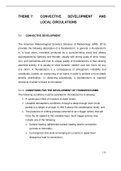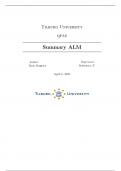THEME 7: CONVECTIVE DEVELOPMENT AND
LOCAL CIRCULATIONS
7.1 CONVECTIVE DEVELOPMENT
The American Meteorological Society’s Glossary of Meteorology (AMS, 2013)
provides the following description of a thunderstorm: In general, a thunderstorm
is “a local storm, invariably produced by a cumulonimbus cloud and always
accompanied by lightning and thunder, usually with strong gusts of wind, heavy
rain, and sometimes with hail. A unique quality of thunderstorms is their striking
electrical activity. It is usually of short duration, seldom over two hours for any
one storm. A thunderstorm is a consequence of atmospheric instability and
constitutes, loosely, an overturning of air layers in order to achieve a more stable
density stratification. In observing procedures, a thunderstorm is reported
whenever thunder is heard at the station.”
7.1.1 CONDITIONS FOR THE DEVELOPMENT OF THUNDERSTORMS
The following conditions must be satisfied for thunderstorms to develop:
A continuous inflow of moisture at lower levels;
Unstable atmospheric conditions, through a deep enough layer (must
persist to a height of at least 10 000 ft above the condensation level); and
The presence of a lifting process (referred to as a trigger action) that will
force the air upward to the unstable layer. Such trigger actions may
include one of the following:
Surface heating (differential surface heating lead to convection
currents or thermals);
Convergence (low level converging air currents or upper level
divergence lead to convection);
135
, Frontal action (cold air undercutting warm air at weather fronts forces
the warm air to rise);
Orographic lift (air forced to rise over a coastline or mountains); or
Nocturnal development (after sunset, long-wave radiation loss from the
tops of mid-level clouds and re-radiation at lower levels give rise to an
unstable lapse rate).
7.1.2 LIFE CYCLE OF A SINGLE CELL THUNDERSTORM
All thunderstorms go through three development stages: the cumulus stage,
mature stage, and the dissipation stage (Figure 7.1). Depending on atmospheric
conditions at the time of its development, these three stages take an average of
30 minutes to an hour to go through.
Figure 7.1 Stages of thunderstorm development (Ahrens, 2007).
CUMULUS STAGE:
All thunderstorms start off as cumulus clouds. At this stage the cell is about 3 km
in diameter, and may grow until it is about 8 km in diameter. The most important
feature is the general updraft that prevails throughout the cell (Figure 7.1 left).
136
,The speed of the updraft may be as much as 15 ms-1. As radar echoes begin to
form they acquire an inverted saucer-like structure, with the strongest echoes in
the upper regions of the cloud. The general updrafts in the cloud cause winds at
the surface to flow towards the cell and converge. During this stage the
temperature in the cloud is warmer than the surrounding air at the same level.
MATURE STAGE:
The updrafts continue and lead to increased condensation, producing larger
water droplets and ice crystals. When these droplets/crystals become too large to
be sustained, they fall out as precipitation and the region of maximum radar
reflectivity subside towards the ground. Once precipitation sets in (usually about
20 minutes after the first radar echoes are recorded), the mature stage has been
reached. The precipitation pulls down air with it, and downdrafts now occur
where previously only updrafts existed (Figure 7.1 centre). Because of the
downdrafts, surface winds start to blow away from the base of the cloud. The air
which is being pulled down is colder than the surrounding air and therefore
anywhere within the cloud the temperature is now colder than the surrounding air
at the same level.
Thunderstorms often build to altitudes of 40 000 – 50 000 ft in mid-latitudes and
to even greater heights (up to 65 000 ft) in the tropical regions. The air starts to
spread out as it hits a stable layer (or the tropopause) to form an anvil. The
greatest diameter is at about 10 000 ft. The shear between the up and
downdrafts at the base of the cloud often produces a roll cloud. This section of
the cloud is also extremely turbulent. This is the most dangerous stage when
large hail, damaging winds, and flash flooding may occur. The mature stage of
one cell may last for as long as 30 minutes.
DISSIPATING STAGE:
Due to the precipitation, the downdraft spreads throughout the cell until it totally
replaces the updrafts, except for the portion at the top of the cloud (Figure 7.1
137
, right). Since the downdraft cut off the updraft, the storm no longer has a supply of
warm moist air to maintain itself and therefore it dissipates and the precipitation
gradually stops. At the top of the cloud some updrafts may still persist and fray
out to enhance the anvil shape. A well-defined anvil is a clear indication that the
thunderstorm has reached the dissipating stage. The dissipating stage also lasts
for about 30 minutes after which all vertical motion becomes insignificant.
7.1.3 TYPES OF THUNDERSTORMS
Thunderstorms can be classified according to the large-scale weather situation in
which they develop, the lifting process involved in their development, or their
structure.
SYNOPTIC CLASSIFICATION
From the viewpoint of the synoptic meteorologist, thunderstorms may be
classified by the nature of the overall weather situation, such as airmass
thunderstorms, frontal thunderstorms, and squall-line thunderstorms.
LIFTING PROCESS CLASSIFICATION
Classification can also be done according to the lifting process (trigger action),
yielding heat thunderstorms (occur during the afternoon); convergence
thunderstorms (may occur any time of the day); frontal thunderstorms (may occur
any time of the day); orographic thunderstorms (may occur any time of the day,
but mostly during the afternoon); and nocturnal thunderstorms (occur during the
evening).
STRUCTURAL CLASSIFICATION
All thunderstorms can be grouped into four classes, namely:
1) Single cell thunderstorms
2) Multi-cell cluster thunderstorms
3) Multi-cell line (squall-line) thunderstorms
4) Supercell thunderstorms
138
LOCAL CIRCULATIONS
7.1 CONVECTIVE DEVELOPMENT
The American Meteorological Society’s Glossary of Meteorology (AMS, 2013)
provides the following description of a thunderstorm: In general, a thunderstorm
is “a local storm, invariably produced by a cumulonimbus cloud and always
accompanied by lightning and thunder, usually with strong gusts of wind, heavy
rain, and sometimes with hail. A unique quality of thunderstorms is their striking
electrical activity. It is usually of short duration, seldom over two hours for any
one storm. A thunderstorm is a consequence of atmospheric instability and
constitutes, loosely, an overturning of air layers in order to achieve a more stable
density stratification. In observing procedures, a thunderstorm is reported
whenever thunder is heard at the station.”
7.1.1 CONDITIONS FOR THE DEVELOPMENT OF THUNDERSTORMS
The following conditions must be satisfied for thunderstorms to develop:
A continuous inflow of moisture at lower levels;
Unstable atmospheric conditions, through a deep enough layer (must
persist to a height of at least 10 000 ft above the condensation level); and
The presence of a lifting process (referred to as a trigger action) that will
force the air upward to the unstable layer. Such trigger actions may
include one of the following:
Surface heating (differential surface heating lead to convection
currents or thermals);
Convergence (low level converging air currents or upper level
divergence lead to convection);
135
, Frontal action (cold air undercutting warm air at weather fronts forces
the warm air to rise);
Orographic lift (air forced to rise over a coastline or mountains); or
Nocturnal development (after sunset, long-wave radiation loss from the
tops of mid-level clouds and re-radiation at lower levels give rise to an
unstable lapse rate).
7.1.2 LIFE CYCLE OF A SINGLE CELL THUNDERSTORM
All thunderstorms go through three development stages: the cumulus stage,
mature stage, and the dissipation stage (Figure 7.1). Depending on atmospheric
conditions at the time of its development, these three stages take an average of
30 minutes to an hour to go through.
Figure 7.1 Stages of thunderstorm development (Ahrens, 2007).
CUMULUS STAGE:
All thunderstorms start off as cumulus clouds. At this stage the cell is about 3 km
in diameter, and may grow until it is about 8 km in diameter. The most important
feature is the general updraft that prevails throughout the cell (Figure 7.1 left).
136
,The speed of the updraft may be as much as 15 ms-1. As radar echoes begin to
form they acquire an inverted saucer-like structure, with the strongest echoes in
the upper regions of the cloud. The general updrafts in the cloud cause winds at
the surface to flow towards the cell and converge. During this stage the
temperature in the cloud is warmer than the surrounding air at the same level.
MATURE STAGE:
The updrafts continue and lead to increased condensation, producing larger
water droplets and ice crystals. When these droplets/crystals become too large to
be sustained, they fall out as precipitation and the region of maximum radar
reflectivity subside towards the ground. Once precipitation sets in (usually about
20 minutes after the first radar echoes are recorded), the mature stage has been
reached. The precipitation pulls down air with it, and downdrafts now occur
where previously only updrafts existed (Figure 7.1 centre). Because of the
downdrafts, surface winds start to blow away from the base of the cloud. The air
which is being pulled down is colder than the surrounding air and therefore
anywhere within the cloud the temperature is now colder than the surrounding air
at the same level.
Thunderstorms often build to altitudes of 40 000 – 50 000 ft in mid-latitudes and
to even greater heights (up to 65 000 ft) in the tropical regions. The air starts to
spread out as it hits a stable layer (or the tropopause) to form an anvil. The
greatest diameter is at about 10 000 ft. The shear between the up and
downdrafts at the base of the cloud often produces a roll cloud. This section of
the cloud is also extremely turbulent. This is the most dangerous stage when
large hail, damaging winds, and flash flooding may occur. The mature stage of
one cell may last for as long as 30 minutes.
DISSIPATING STAGE:
Due to the precipitation, the downdraft spreads throughout the cell until it totally
replaces the updrafts, except for the portion at the top of the cloud (Figure 7.1
137
, right). Since the downdraft cut off the updraft, the storm no longer has a supply of
warm moist air to maintain itself and therefore it dissipates and the precipitation
gradually stops. At the top of the cloud some updrafts may still persist and fray
out to enhance the anvil shape. A well-defined anvil is a clear indication that the
thunderstorm has reached the dissipating stage. The dissipating stage also lasts
for about 30 minutes after which all vertical motion becomes insignificant.
7.1.3 TYPES OF THUNDERSTORMS
Thunderstorms can be classified according to the large-scale weather situation in
which they develop, the lifting process involved in their development, or their
structure.
SYNOPTIC CLASSIFICATION
From the viewpoint of the synoptic meteorologist, thunderstorms may be
classified by the nature of the overall weather situation, such as airmass
thunderstorms, frontal thunderstorms, and squall-line thunderstorms.
LIFTING PROCESS CLASSIFICATION
Classification can also be done according to the lifting process (trigger action),
yielding heat thunderstorms (occur during the afternoon); convergence
thunderstorms (may occur any time of the day); frontal thunderstorms (may occur
any time of the day); orographic thunderstorms (may occur any time of the day,
but mostly during the afternoon); and nocturnal thunderstorms (occur during the
evening).
STRUCTURAL CLASSIFICATION
All thunderstorms can be grouped into four classes, namely:
1) Single cell thunderstorms
2) Multi-cell cluster thunderstorms
3) Multi-cell line (squall-line) thunderstorms
4) Supercell thunderstorms
138












